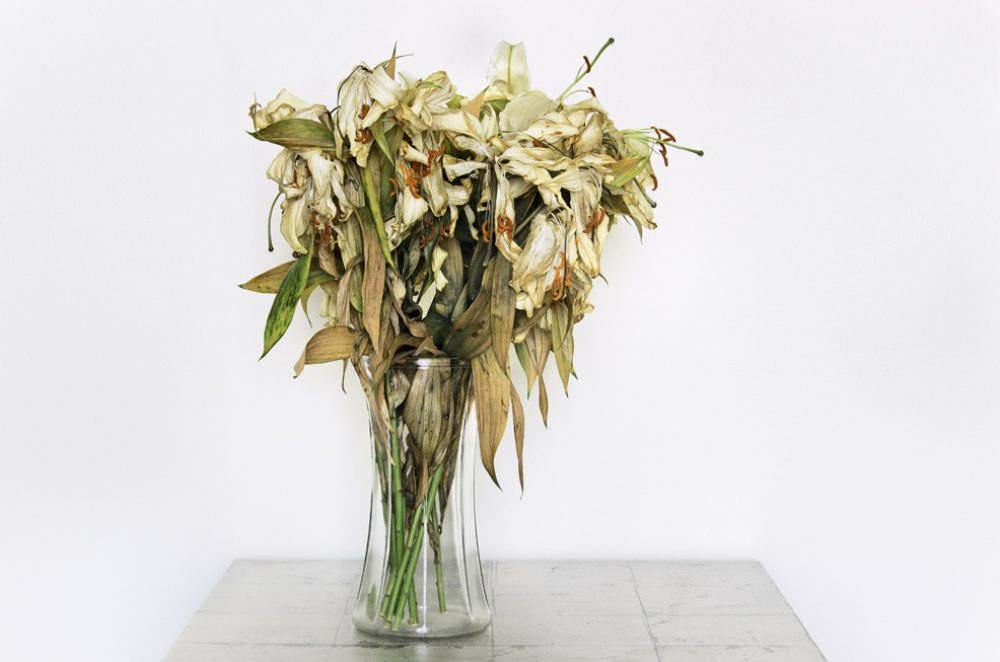What Remains: Les Schmidt at Guy Lyman Fine Art
Laurence Ross looks at Les Schmidt’s portraits of withering bouquets and contemplates memory and loss.

Les Schmidt, Lillian, 2015. Archival pigment print. Courtesy the artist and Guy Lyman Fine Art, New Orleans.
But when the days of golden dreams had perished
And even Despair was powerless to destroy,
Then did I learn how existence could be cherished,
Strengthened and fed without the aid of joy;Emily Brontë, “Remembrance”
A pressed flower is a romantic notion, whether the flower preserves a moment of joy or a moment of pain. Though it finds its origins in 16th-century Japan, the pressed flower’s popularity in Victorian England makes it cousin to exchanged locks of hair, loved ones forever knotted. One can easily imagine Oscar Wilde, Emily Brontë, Robert Browning, or even a young Virginia Woolf pressing flowers between the pages of their books. And this tender impulse to press a flower was the catalyst for Les Schmidt’s exhibition, “Dorothy Jean.”
“Dorothy Jean,” a series of photographs that captures bouquets at a stage somewhere between life and death, arose out of Schmidt’s remembering his mother via a pressed red rose. Though the setting of each photograph is nearly uniform—white wall, tiled table, glass vase—the contents of these vases are more diverse. Some consist of a single species of plant while others offer more variety. For Schmidt, the process of watching these cut flowers go through their life cycle would cause an association, the memory of a particular friend or family member, to emerge and therefore lead to the title of the photograph—the loved one’s name. We can assume the contents, whether uniform or eclectic, crowded or sparse, are emblematic of the person. Laszlo, a photograph that actually contains no flowers at all, could be the product of a botanist or an avid nature walker— rosemary and eucalyptus peeking out from a cluster of other disparate flora.
The colors and textures of Lillian are so soft and tactile that they seem the product of a paint brush rather than a camera lens. I can easily place in the frame a bunch of grapes, imagine the sheen of a shucked oyster, replace the stark tile with dark wood, add a tasseled table runner, a skull. The ghosts of 17th-century vanitas symbols begin to pile up.
Yet in reality, these photographs lack that rich background, and I try to make sense of the stark whiteness with which we are presented. The lack of context brings to mind, momentarily, Japanese Ukiyo-e woodblock prints, where a wave or a tree may be ungrounded in a “floating world.” And then, perhaps because I’ve spent the afternoon leafing through images of Byzantine icons hovering on gold-gilded backdrops, the white begins to evoke the realm of the spiritual into which some of these friends and relatives have passed.
Flowers in art—and in death—are no new thing, as life and death have served as a fruitful seed for many an artist. A powerful example that comes to mind is Alexander McQueen’s floral dress exhibited in “Savage Beauty” at the Metropolitan Museum of Art in New York, rendered from a makeshift textile of natural flowers that bloom and dry juxtaposed with fake flowers interwoven throughout. That dress is both alive and dead, the mannequin a sort of modern-day Sleeping Beauty stepping toward us with a ribbon-wrapped leg, encased in her Plexiglas coffin. Another example: through the medium of public ritual, the Day of the Dead will take place once again next week, marigolds carried or worn in the hair, as the lives of lost loved ones are celebrated. In the end, perhaps what is most unique about Schmidt’s project is the implied request for the viewer to personify these images, to see if we can see what he has seen, or some likeness of that loss.
What I want to see most, however, is palpably absent. (Perhaps apropos, given the subject.) I wonder: what is the current state of these bunches of flowers? Have they turned too far toward death and been discarded? I yearn to see the real thing, positioned in front of the pristine presentation of these memories/fantasies/photographs, even if all that is left is the dust, the crumbled remains. Or maybe a fresh bouquet. For, as Emily Brontë reminds us, we should not linger in such a melancholic state for too long:
And even yet, I dare not let it languish,
Dare not indulge in Memory’s rapturous pain;
Once drinking deep of that divinest anguish,
How could I seek the empty world again?
Editor's Note
“Dorothy Jean” is on view through October 31, 2015 at Guy Lyman Fine Art (3645 Magazine Street) in New Orleans.



